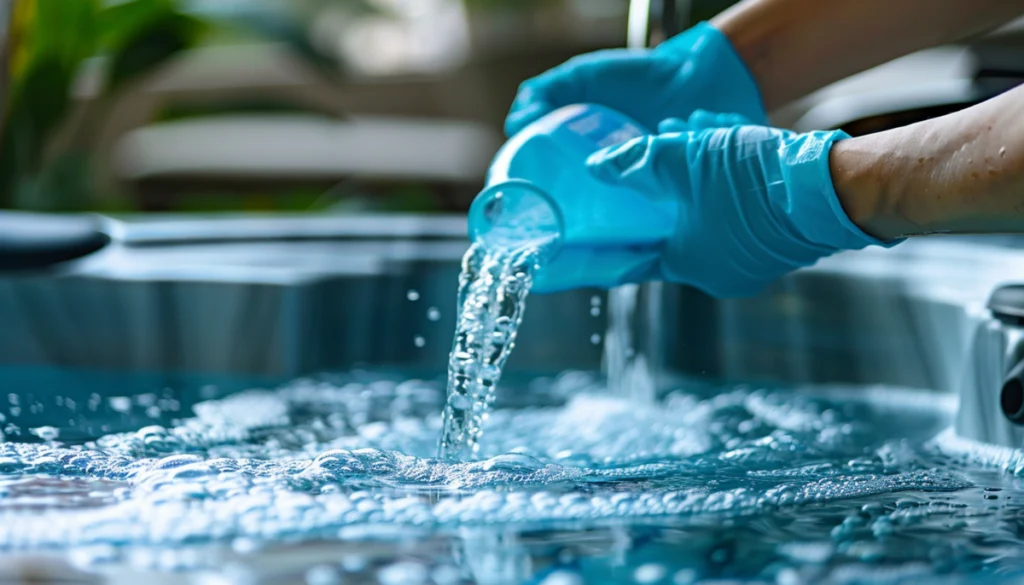Maintaining a hot tub requires a diligent care routine that includes “shocking” the hot tub. Regularly shocking your hot tub or spa helps to break down organic waste products such as oils, skin cells, and cosmetics that regular filtration can miss.
This prevents the proliferation of microbes that can pose health risks. Regular maintenance, including proper shocking, can significantly extend the lifespan and performance of your hot tub. In this blog, we’re taking a look at what shocking is and how to do it.
Whether you’ve recently purchased a mammoth-sized spa like the Tranquility Harbor or a more compact model like the Twin Palms, you’re going to need this information.
What is Hot Tub Shock?
Hot tub shock treatment is a crucial maintenance task that involves adding a chemical oxidizer to the water. This process sanitizes the water by breaking down and eliminating organic contaminants and chloramines, which are by-products that can cause undesirable odors and irritate the skin and eyes. There are two primary types of shock treatments used in hot tubs: chlorine-based and non-chlorine shocks.
Chlorine-based shocks are really great for sanitizing and oxidizing the water quickly. They are ideal for dealing with significant contamination after heavy use or for routine maintenance. On the other hand, non-chlorine shocks are gentler. They are used primarily for oxidizing the water without boosting chlorine levels, making them suitable for regular use to keep the water fresh without the strong odor of chlorine.
Necessary Tools and Safety Gear
Before shocking your hot tub, you’ll want to gather all the necessary tools and ensure you have the appropriate safety gear. You’ll need a measuring cup for precise dosing of the shock product, hot tub test strips to check the chemical levels before and after shocking, and the shock treatment chemical itself, either chlorine-based or non-chlorine.
Safety is paramount when handling these chemicals, so it is important to wear chemical-resistant gloves and safety goggles to protect your skin and eyes. Additional protective clothing, such as long sleeves, trousers, and closed-toe shoes, are a good idea as well.
Step-by-Step Guide to Shocking Your Hot Tub
Shocking your hot tub or spa can be broken down into several key steps to ensure effectiveness and safety:
- Testing and Adjusting Water Chemistry: Begin by using hot tub test strips to check the water’s pH and alkalinity levels. The ideal pH level should be between 7.2 and 7.6. If necessary, adjust these levels using pH increasers or decreasers.
- Adding the Shock: Once the water chemistry is balanced, slowly add the measured amount of shock directly to the hot tub water, following the manufacturer’s instructions closely. You may need to add more shock for hot tubs with a higher water volume, such as swim spas.
- Aftercare Following Shock Treatment: Keep the hot tub’s circulation system running to help distribute the shock throughout the tub. Leave the hot tub uncovered during this period to allow for gas-off of chemical byproducts, typically for at least 20-30 minutes. After this period, test the water again to ensure the chemical levels are safe and the shock has been effective.
When and How Often to Shock Your Hot Tub
We recommend shocking your hot tub:
- After Heavy Use: If the hot tub has been used by several people or for extended periods, it’s wise to shock it immediately afterward to handle the increased load of contaminants.
- Regular Maintenance: Shocking the hot tub at least once a week is advisable for regular users. This helps keep the water clear and free of harmful bacteria and other organic compounds that can accumulate over time.
The best time to add shock to your hot tub is during the evening or at night. UV light from the sun can quickly degrade chlorine levels, making the shock less effective. Shocking your hot tub at night ensures that the chemicals have sufficient time to work without being diminished by sunlight.
Troubleshooting Common Issues
Even with regular maintenance, you might encounter some issues. Here are common problems and how to address them:
- Foamy Water: This can occur due to high levels of body oils, lotions, and detergents in the water. To reduce foam, shock regularly and consider using a foam reducer if the problem persists.
- Strong Chlorine Smell: A strong chlorine smell indicates the presence of chloramines, which are ineffective at sanitizing and indicate that it is time to shock your hot tub. Shocking breaks down chloramines and restores chlorine’s effectiveness.
- Cloudy Water: This is often a sign of inadequate filtration or a chemical imbalance. Check and clean the filters, and make sure the water chemistry is balanced. Shocking the hot tub can also help clear up cloudy water by oxidizing the particulates that cause cloudiness.
Final Thoughts on Shocking Your Hot Tub
Properly shocking your hot tub is essential to maintaining a clean, safe, and enjoyable spa environment. Regular shocking helps eliminate harmful bacteria, reduce odors, and maintain clear water, enhancing the overall hot tub experience. It also ensures that the chemicals in the water stay balanced, preventing damage to the hot tub components and irritation to users’ skin and eyes.
We recommend incorporating shock treatment into your regular hot tub maintenance schedule to ensure the longevity of your hot tub and create a more inviting and hygienic space for relaxation and enjoyment.






